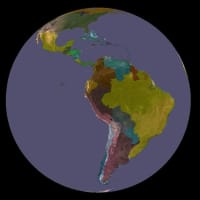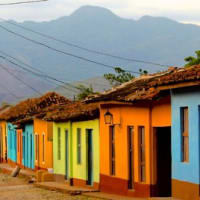卒業試験は、どの専攻の生徒もこたえられるよう、ひろーい感じの質問設定となっています。正しい答えというのは無く、自分の持つ知識を用いて議論し、結論を導き出し、それを読み手に納得させられれば合格です。私は政治経済学専攻なので、ほぼすべての質問に関して政治経済ネタを引っ張り出して作文しました。また、基本的には、2、3か国について具体的に論じることが求められました。
2年間で学んだフレームワークを使いこなせるかをテストしようという意図からか、単なる時事問題(最近の出来事を知っている知らない)に止まらず、大局的な見地からラテンアメリカを論じさせる質問ばかりでした。
例えば、「1970年代と現在のラ米を比較してみると、どちらのほうがマシか?」
そんな感じの想定問に答えるべく、試験勉強中にこしらえた文章がこんなかんじです。ももごろうは好きなアルゼンチンとペルーを選んで書きました。(ちなみに、1970年代よりも現在をかなりほめていますが、もちろん、まだまだ問題は山積みです。そうした問題については次のブログで詳しく・・・。)
ところで、「現在」というのは2016年はじめを想定して解答を作文しており、例えば、ペルーについては2016年8月に退任したウマラ政権の政策について論じて、現大統領については触れていません。念のため。
<簡単な翻訳は以下のとおり>
ブラジルやベネズエラなど一部の国を除き、ラ米諸国の政治経済状況は、70年代と比べて明らかに良い状態にある(国により程度は異なる)。2000年代より政治経済状況が安定し、その結果、はじめて中産階級の人口が貧困層のそれを上回った。
大恐慌以来、1980年に至るまで、ラ米諸国は軍事政権と文民政権が目まぐるしく入れ替わり、それぞれの政権が異なる政策をとったことで、政治経済状況は不安定極まりなかった。また、これが原因となり、公正な成長(growth with equity)のための処方箋がラ米には長らく欠如していた。ペルーはコモディティ輸出依存による経済の不安定さや貧困や格差を是正するため、1960年代終わりに輸入代替工業化政策(ISI)をとったが、同政策によって輸出はさらに悪化。その結果、経済成長率も低下。インフレは加速。対外債務は急速に増加。また、ペルーは、歴史を通じて、貧困や格差という課題に対し、一貫した政策をとったことが無かった。ISIのもと拡充された社会保障制度は、フォーマルセクターの労働者を対象としたものが中心であり、経済格差も拡大。1970年代、年間3%の経済成長率を達成したに拘わらず、貧困率は約50%に高止まり。アルゼンチンはペルーよりも早い時期にISIを導入したが、1970年代半ばにはその開発モデルは限界を迎え、ペルーより悪い政治経済状況にあった。経済成長率は低迷、ISI政策・ポピュリズム政策により公的部門は肥大化し、財政赤字や対外債務は急速に拡大、インフレが急速に加速した。1976年には、インフレ率は450%に達した。経済の停滞により、労働階級と富裕層の経済・社会的格差はますます拡大し、これがさらなる政治の分極化につながっていった。1976年はまた、アルゼンチンで「汚い戦争」が始まった年でもある。アルゼンチンが混乱のさなかにあったことは容易に想像できる。
このような状況はここ30年の間に様変わりした。民主主義がラ米におけるほとんどの国で確立され、2000年代の継続的な経済成長により、同地域に社会的な安定と進歩がもたらされた。1990年代終わりの通貨危機後、ラ米ほとんどの国が2000年代もネオリベラル改革を推し進めた。その結果、ラ米諸国のマクロ経済ファンダメンタルズは健全化した。また、2000年代のコモディティ・ブームも追い風となり、ラ米諸国は堅調な経済成長を維持するとともに、貧困率や格差、失業の面でも大きな改善を実現した。この結果、史上初、中産階級の人口が貧困層の人口を上回った。
ペルーの自由化政策は政権が変わっても継続的に受け継がれてきた。これに慎重な経済運営も相まって、同国はコモディティ価格の「スーパーサイクル」終焉後においても、財政・金融バッファーを構築し続けている。また、左派のウマラ大統領は「包括的成長」をスローガンに掲げ、条件付現金給付(Conditional Cash Transfers)を拡大するとともに、開発社会包摂省を設立した。他方、アルゼンチンの政策はペルーほど継続性が無い。1990年のワシントン・コンセンサス以降推し進められた市場原理重視の政策は、ポピュリストのキルチネル政権(2003~2015年)のもと、再度ISIに逆戻りした。それでも、コモディティ・ブームの恩恵を受け、農業の輸出が拡大し、アルゼンチンは安定した経済成長を続けた。潤沢な財源を利用し、政府は医療と教育に積極的に投資した。
この結果、ペルー、アルゼンチンともに貧困率削減や格差の是正が進み、中産階級が拡大した。2016年には、コモディティ価格の「スーパーサイクル」が終わったに拘わらず、ペルー経済は成長を続け、低いインフレ率を保ち、貧困や格差の面においても改善が続く。1970年代には50%に達していた貧困率は、2016年には約20%となっている。一方のアルゼンチンではこうした好ましい傾向は2012年で終了。また、マクリ新大統領のオーソドックスな経済政策により、肥大化した公的部門では大規模な解雇が行われ、エネルギー等の補助金削減によりインフレは高騰しており、その結果、大規模な抗議活動が行われている。しかしながら注目すべきは、アルゼンチンでは、1970年代半ばで見られたような社会混乱は見られていないということである。
以上、1970年代と比較すると、ラ米の多くの国において、政治的、また、社会的安定性は大いに向上した。アルゼンチン、ペルーともに、程度の差はあれ、包括的成長という面で大いに前進したと言えよう。よって、1970年代と比べると、現在のラ米の状況は改善したといえる。
<以下、オリジナルの作文>
Despite apparent setbacks in several countries (such as Brazil and Venezuela) in the recent years, in a bigger picture, Latin America is now undoubtedly in a better shape compared to 1970s. First, since the last decade, Latin America, as a whole, has been enjoying more economic and political stability (although its extent varies among different countries). And consequently, for the first time ever the region has more middle class than poor. This is a positive development because the middle class is frequently considered an engine of socioeconomic development (Birdsall).
Since the Great Depression until the 1980s, Latin American countries had a succession of military and democratic presidents who did not last long in office. Different governments implemented widely different policies, thus economies failed to stabilize (Lockhart). Apart from the political and economic instability, Latin American states had not developed the “recipe” to achieve a growth with equity for long. Historically, Peruvian government had not taken any systematic approach to social service delivery (World Bank). Peru implemented its Import-Substitute Industrialization (ISI) model in late 1960s in response to economic volatility (due to its commodity export-led economic model), inequality and poverty. However, export performance under ISI was dismal (Arce), and GDP growth decelerated, inflation soared, while foreign debt piled up. ISI policies also failed to redistribute income toward the poor. While those in the formal sector benefited, those in the informal sector continued to be excluded from social security. The industrialization took place mostly in Lima, so those who lived in the rural area did not benefit from ISI. Poverty remained constant at around 50 percent of the population during the 1970s, in spite of the annual economic growth that averaged 3 percent (World Bank).
Argentina, who had implemented the ISI model earlier, was even in a worse situation in the mid-70s. Due to the exhaustion of the ISI model and increasing inequality between the working class and the wealthy, Argentina was in the midst of social and political turmoil. Its economic growth had stagnated, and the bloated public sector resulted in skyrocketing financial deficit, inflation, and external debt. Indeed, inflation reached 450 percent in 1976 (Rozenwurcel). Due to the stagnation of the economy, social and economic conditions among the working class deteriorated and inequality rose. Such rising inequality contributed to increasing polarization of politics (Marvin). In the same year, President Isabel Peron was ousted by a military coup, and thereafter the “Dirty War’ was initiated, during which civil rights violations took place, according to evidence (Donghi). Obviously, in such situation, Argentina could not improve poverty and inequality situation.
The situation has deeply changed over the past 30 years. Democracy has been established almost everywhere, and its sustained economic growth in the last decade has brought social stability and progress to the region (Ocampo), because in principle, democracy should reduce societal inequalities (Smith). After the currency crisis at the end of the 1990s, most of the countries continued its neoliberal reforms in the 2000s, thanks to which macroeconomic fundamentals were improved. Furthermore, helped by the commodity boom, Latin America could maintain a prolonged economic growth and achieve a significant reduction in poverty and inequality and unemployment rates (Ocampo). Such accomplishments have led to an expansion of middle class which now outnumbers those living in poverty (de la Torre).
Peru’s liberalization reforms have continued over different presidential administrations until today, even including the left-wing President Humala. This, coupled with its prudent economic management, Peru has continued to accumulate and carefully managed its sizable fiscal and monetary buffers even though the commodity supercycle has ended (IMF Article IV). On the other hand, President Humala has focused on social programs for the poor to achieve an inclusive growth, introducing several conditional cash transfer programs (CCTs), founding the Ministry of Development and Social Inclusion, and initiating education and health reforms (BTI).
Argentina’s policy continuity was not as enduring as that of Peru: the populist Kirchner Administration (2003-2015) reversed the Washington Consensus-led policy followed in the 1990s by ISI model. However, thanks to the prolonged commodity boom and its expanded agricultural exports, the government could invest heavily in health and education (World Bank). Moreover, the country prioritized social spending through various programs.
As a result, both countries have successfully reduced poverty ratio and inequality ratio, and the middle class expanded. In 2016, in spite of the end of the commodity supercycle, Peru’s economy is continuing to grow with low inflation, and the poverty and inequality situation continue to improve. In Argentina, such favorable trend has stalled since 2012 (World Bank). Moreover, new President Macri’s orthodox economic policies have resulted in massive layoffs in the bloated public sector. Reduction in energy and transport subsidies have caused an inflation spike (EIU). There have been massive protests. However, the country is not having the same level of social turmoil as in the mid-70s.
Compared to the 1970s, the political and social stability has improved dramatically now. Especially in Peru, coupled with a sound macroeconomic management, such stability has allowed its governments to implement consistent economic policies for a prolonged time, and tackle the poverty and inequality issues even after the commodity boom has ended. Argentina lacks consistency in its economic policy, however, has successfully made improvements on the social front. It seems that the two countries have made an important step to achieving a growth with equity. These are the reasons why we can conclude that Latin America is better off now compared to the 1970s.











